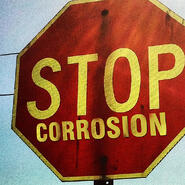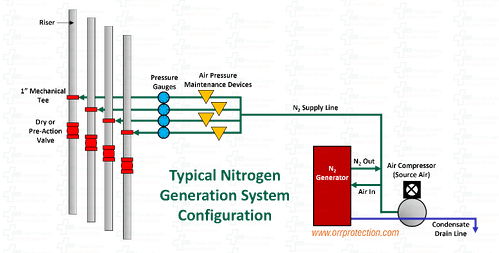Steel pipes corrode quickly in dry sprinkler systems. The concepts behind corrosion and MIC are explained in this blog:Understanding Corrosion and Microbiologically Induced Corrosion (MIC). Both wet and dry (pre-action) sprinkler systems have corrosion issues, but they are dramatically worse in dry systems.

New and existing sprinkler systems can benefit by the application of a nitrogen generation system. For new sprinkler installations, application of nitrogen can dramatically improve the lifespan of the system. For existing installations where corrosion has already started, the piping can be preserved by using nitrogen instead of compressed air. Nitrogen can add considerable useful life to the sprinkler system.

In a nitrogen generation system, compressed nitrogen is substituted for compressed air. Normally, dry and pre-action systems utilize an air compressor to provide the pressure in the system. Most systems are maintained at 30 to 50 PSIG (2 to 4 Bar); a custom setting is required for each system. A pressure switch that is wired to the fire alarm system monitors the air pressure and generates a supervisory signal at the fire alarm panel if the pressure drops. The primary reason for a loss of pressure is a fire that fused a sprinkler head releasing system pressure before filling the pipe with water. In addition to supervising the condition of the pipe, the air pressure serves to keep the dry pipe valve closed and keep water out of the system.
Most nitrogen generators extract nitrogen molecules out of air through the use of specialized membranes. They require a compressed air source of at least 125 PSIG for the membranes to operate, which is usually an air compressor provided with the generator. The pressurized nitrogen that exits the generator is piped to the dry or pre-action riser through an air pressure maintenance device, just like it would be for a compressed air system.
Some systems utilize compressed nitrogen cylinders obtained through an industrial gas supplier instead of a nitrogen generator. While the end result is the same, many building owners have safety concerns with high pressure cylinders in their buildings.
The benefits of using compressed nitrogen can be dramatic. The best nitrogen generators create 98% pure nitrogen. Accelerated corrosion studies have shown that nitrogen can extend the life of black steel piping systems from 16 to 48 years, and galvanized pipe from 7 to 92 years. When comprehending these longevity results, it is important to remember that galvanized pipes often fail faster than black steel in air-only sprinkler systems because of concentrated corrosion action at small holes in the zinc coating. Upon seeing this data many engineers recognize that significant cost savings can be realized by using black steel pipe in combination with a nitrogen generator and forego specifying galvanized steel pipe for dry systems.
To ensure dry and pre-action valves will operate when called upon, fire codes require an annual trip test which discharges water into the dry system. Drainage of the water is also required, but it is hard to get a system completely dry. The use of a nitrogen generation system can help to dry a system out over time. The nitrogen that is produced in the generator is very dry (dewpont of -71° F). Over several weeks of operation, a system will be completely dry because of the nitrogen system. The oxygen deficient environment, void of moisture, eliminates two legs of the corrosion triangle.
ORR Protection Systems offers many solutions for combating corrosion in sprinkler systems including diagnosis and prevention options. We also install and service nitrogen generator systems. Know for sure if your system is at risk. We will ensure your all your fire protection systems are ready to perform when called upon. Click here to schedule an appointment today.





